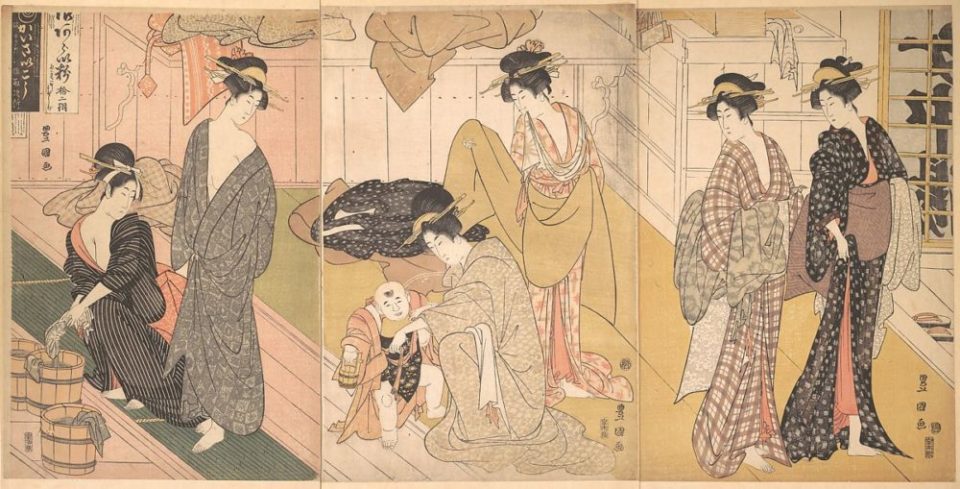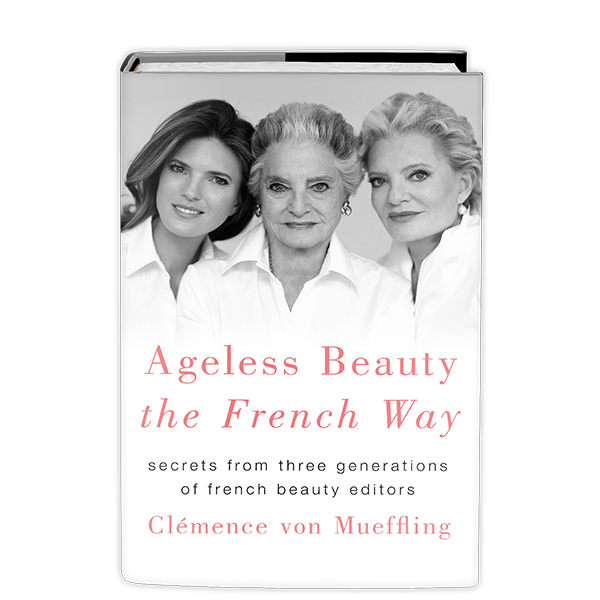Beauty Rituals through the Lens of Art
Passed on by tradition, beauty rituals strive to achieve an ideal of perfection that is different from one period & one country to the next.
Museum collections around the world hold treasures of ancient beauty secrets. For example, we have found traces of makeup in ancient jars, on mirrors and on bone sticks. Art depicts beauty rituals in a wide variety of media including paintings, drawings, ceramics and photographs. Passed on by tradition and influenced by climate and local living conditions, beauty rituals strive to achieve an ideal of perfection that is different from one period, one country and one continent to the next.
Cleopatra’s Smokey Eye
In Ancient Egypt, it was all about the eyes. Deities, Pharaohs and members of their courts outlined their eyes with green or black paint to emphasize their size and shape. After mixing ground pigments of green malachite with water to form a paste, the Ancient Egyptians later began using black kohl, produced from the mineral galena. Aside from enhancing the eye, kohl protected the eye from infections caused by sunlight, dust, or flies.
When examining tombs, you may find some of the most elaborate items are cosmetics cases. For example, the Metropolitan Museum of Art’s collection has a cosmetics case with intricate carvings on the outside, as well as a mirror and four containers on the inside. These containers most likely held kohl, creams, oils, and unguents. For instance, people would apply honey to the skin to help heal and fade scars. Alternatively, they also crushed lotus flowers and applied the oil from various plants (such as papyrus) to the skin. In addition to the health benefits of protecting the skin from the sun, these potions helped ward off sand, flies and other insects.

Cosmetic Box of the Royal Butler Kemeni, Egypt, Middle Kingdom, ca.1805 B.C. Metropolitan Museum of Art
While beauty rituals and impeccable grooming were essential to the kings and queens in Ancient Egypt, the self-care bath that we know and love began somewhere else. In fact, the use of water for daily ablutions begins in Greece.
Plato’s Post-Workout Shower Rituals
The Ancient Greeks set up their bathing facilities next to the gymnasium where people practiced different sports and games. Further, many vase paintings show that the Greeks used other devices aside from various pools. For example, some depictions suggest a distant version of what we could call a shower today.

Jar (stamnos) with female athletes bathing.
Greek Vase © Greek Classical Period, 440–430 B.C., Museum of Fine Arts, Boston
This ancient Greek jar features a scene of a bath house. Four women stand around a large basin. The young woman to the far right may be a slave assisting the women in their bathing. The women use strigils to clean themselves. These curved metal implements helped scrape dirt and oil from the surface of the skin. It will come as no surprise to you that one of the most common things used in ancient Greek beauty regimes was olive oil. In fact, the rich moisturizing texture was perfect for applying to dry skin to keep it soft and supple.
The More, the Merrier: Communal Baths
The Romans expanded on the Greek pipe and drainage system, creating vast aqueducts that supplied indoor plumbing and bathhouses with water. Public bathhouses were essentially the ancient form of spas, offering massages, exercise, and entertainment. Perhaps more importantly, the bathhouse was also a prime meeting place for socializing. In fact, most cultures in the world have developed their own sophisticated bathing rituals since ancient times — whether for hygienic, religious, therapeutic, or even social purposes.

Women and an Infant Boy in a Public Bath House, Utagawa Toyokuni (Japanese, 1769–1825)
Edo period (1615–1868), ca. 1799, Japan
In Japan, they developed public bathhouses throughout their communities known as Sento and Onsen. Tracing back to the Heian period (794-1185), the first public bath in Edo (now Tokyo) was built in 1951. They rose in popularity and boomed after WWII when many homes didn’t have their own bathing facilities. Sento differ from Onsen (hot springs) as they don’t generally use natural spring water. Each Onsen boasts different benefits depending on the minerals in its water. In fact, scholars argue about the extent to which bathers absorb the minerals of the water. However, the centuries of widespread dedication to bathing stands as testament to the experiential benefits of the tradition.
Cleansing Body & Soul
In Islam, spirituality and daily rites of purification go hand in hand. As the religion spread in the early 7th Century, Turkish baths opened from Fes to Constantinople and along the Silk Road. Turkish baths, or hammams, likely developed from Roman and Byzantine baths. However, the concept of extreme cleanliness held a more spiritual significance. In other words, purifying the body intersected with purifying the soul. Depending on their location, women and children used hammams during part of the day, while men could then use them until late evening.
The longevity of this sacred ritual implies that the products used in a hammam continue to be the same. In addition, they contain simple ingredients that promot incredible results. You can actually incorporate some of the traditional hammam products into your everyday life: Rhassoul Clay, Black Soap and Argan Oils.

© Le Bain Turc, by Jean Auguste Dominique Ingres, 1863, Museé du Louvre, Paris
In “Turkish Baths,” 19th century, French artist Jean Auguste Dominique Ingres translates the intimate nature of a hammam. As such, he depicts dozens of nude Turkish women sitting or lying on sofas in various poses, with Oriental décor around a pool. Many of these bathers are emerging from the water, stretching themselves or dozing off. Having never had access to a hammam, Ingres based his painting on the letters of Lady Montague (1690-1760). Lady Montague recounts a visit to women’s baths in Istanbul in the early 18th century. Ingres’ masterpiece grasps at reality, but instead depicts a fantasized version of a beauty ritual in Islamic cultures. As a result, he reminds us that not all art is an accurate representation of reality.
Salon Rituals & The Hair Identity
In many cultures across the globe, hair maintained a significant role in beauty rituals. For example, oils have long been essential for conditioning women’s hair. In particular, haircare in Africa serves as an integral means of expression and signification. Hairstyles may reflect one’s status, gender, ethnic origin, leadership role, personal taste, or place in the cycle of life. The options for hair are endless: short, long, braided or modeled with crests. Finally, it can be oiled, dyed, or rubbed with different pigments.

School of Beauty, School of Culture (2012), Kerry James Marshall. Birmingham Museum of Art. Courtesy of the artist and David Zwirner; © Kerry James Marshall
School of Beauty, School of Culture (2012) is a large painting by one of today’s most important American living artists, Kerry James Marshall. He invites the viewer into a beauty school filled with Black female and male figures. As the title suggests, the scene is more than just a beauty salon. In other words, the familiar setting not only teaches a trade but also educates clientele about black culture in America today.
Throughout the painting, Marshall strategically places cultural signifiers, such as the poster for Lauryn Hill’s Grammy-award winning album, The Miseducation of Lauryn Hill (1998). He poses and magnificently embellishes the female figures in contemporary fashion. Alternatively, a strange and stretched shape in the foreground functions as an anamorphic image of a blonde, white woman. This abstraction serves as a jarring invasion from another reality and represents a parallel standard of beauty.
Marshall places his black subjects in a context that is meaningful to them personally, but more broadly as a culture. For many Black women, beauty salons serve as a place of refuge in a world that negates their value. In conclusion, the beauty is that the limits of a salon are boundless as a place of cultural expression.
Art as a Holistic Record of Beauty Rituals
There are countless examples of beauty rituals in art history. Artists have long depicted self-care regimens of the world’s past. A woman in China will not comb her hair the same way a woman in Egypt would, but art allows us to encapsulate it all. As a result, we are able to appreciate that beauty across the globe does not fit one standard but includes all.
Beatrice Del Favero is an art historian, archive curator, author, speaker and training specialist. After spending thirteen years as a researcher and lecturer at the Metropolitan Museum of Arts, she now assists some of the world’s most iconic luxury brands in their exhibitions, books, archives, and retail training curricula. Visit her instagram @artstacksandgems to explore the intersections of her favorite art and jewelry pieces.
Sources:
Amiot-Saulnier, Emmanuelle. Gavoille, Aurèlie. L’Orient des Peintres, du rêve à la lumière. [Exposition, Paris, Musée Marmottan Monet, du 07/03/2019 au 21/07/2019]. Paris
httpss://www.amayori.com/pages/japanese-bathing-rituals
httpss://www.bbc.com/culture/article/20160204-how-ancient-egypt-shaped-our-idea-of-beauty
httpss://societyreflectedinart.wordpress.com/
httpss://www.vogue.co.uk/article/japanese-onsen-bathing-rituals







